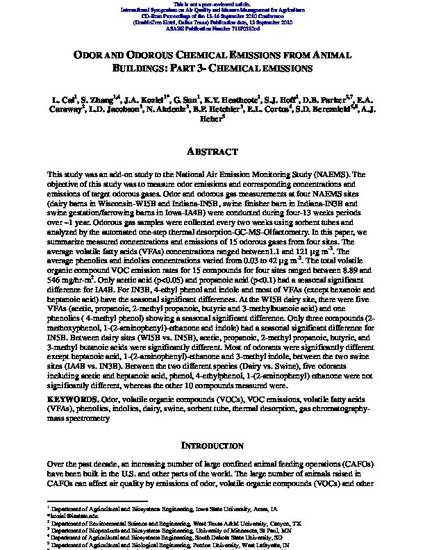
This study was an add-on study to the National Air Emission Monitoring Study (NAEMS). The objective of this study was to measure odor emissions and corresponding concentrations and emissions of target odorous gases. Odor and odorous gas measurements at four NAEMS sites (dairy barns in Wisconsin-WI5B and Indiana-IN5B, swine finisher barn in Indiana-IN3B and swine gestation/farrowing barns in Iowa-IA4B) were conducted during four-13 weeks periods over ~1 year. Odorous gas samples were collected every two weeks using sorbent tubes and analyzed by the automated one-step thermal desorption-GC-MS-Olfactometry. In this paper, we summarize measured concentrations and emissions of 15 odorous gases from four sites. The average volatile fatty acids (VFAs) concentrations ranged between1.1 and 121 µg m -3 . The average phenolics and indolics concentrations varied from 0.03 to 42 µg m -3 . The total volatile organic compound VOC emission rates for 15 compounds for four sites ranged between 8.89 and 546 mg/hr-m 2 . Only acetic acid (p<0.05) and propanoic acid (p<0.1) had a seasonal significant difference for IA4B. For IN3B, 4-ethyl phenol and indole and most of VFAs (except hexanoic and heptanoic acid) have the seasonal significant differences. At the WI5B dairy site, there were five VFAs (acetic, propanoic, 2-methyl propanoic, butyric and 3-methylbuanoic acid) and one phenolics ( 4-methyl phenol) showing a seasonal significant difference. Only three compounds (2-methoxyphenol, 1-(2-aminophenyl)-ethanone and indole) had a seasonal significant difference for IN5B. Between dairy sites (WI5B vs. IN5B), acetic, propanoic, 2-methyl propanoic, butyric, and 3-methyl butanoic acids were significantly different. Most of odorants were significantly different except heptanoic acid, 1-(2-aminophenyl)-ethanone and 3-methyl indole, between the two swine sites (IA4B vs. IN3B). Between the two different species (Dairy vs. Swine), five odorants including acetic and heptanoic acid, phenol, 4-ethylphenol, 1-(2-aminophenyl) ethanone were not significantly different, whereas the other 10 compounds measured were.
Available at: http://works.bepress.com/steven_hoff/16/

This proceeding is from International Symposium on Air Quality & Manure Management for Agriculture CD-Rom Proceedings (13–16 September 2010, Double Tree Hotel, Dallas Texas) St. Joseph, Michigan: ASABE, 13 September 2010. ASAE Pub #711P0510cd.